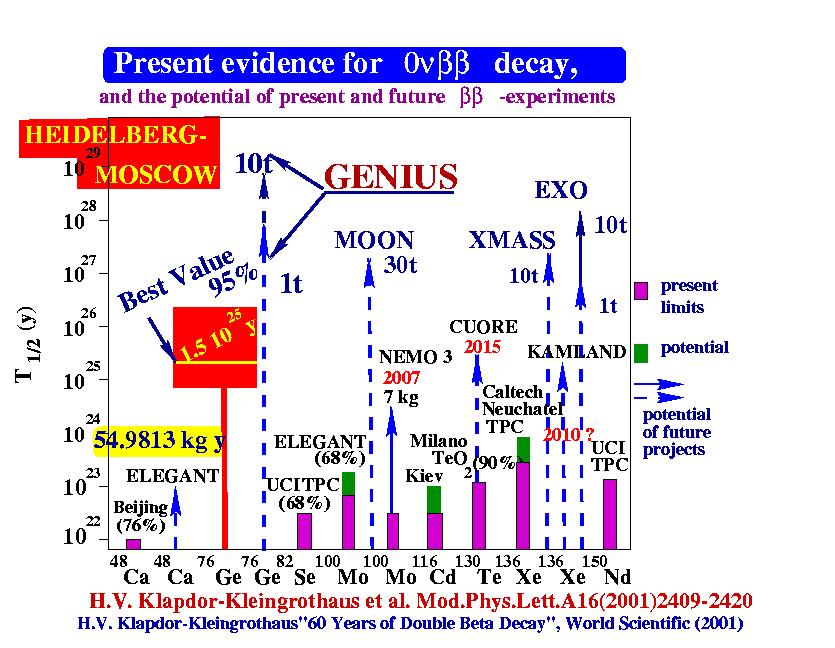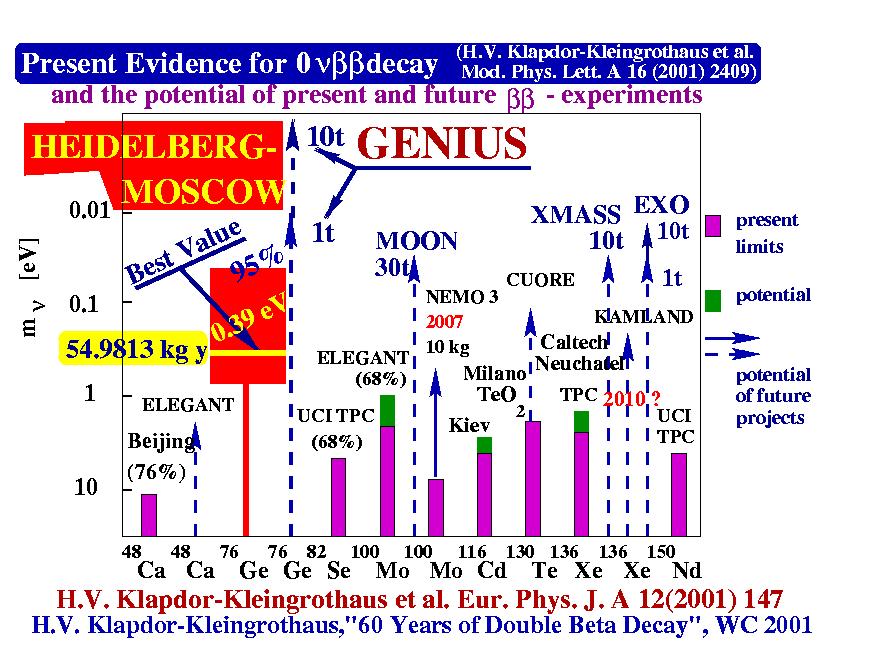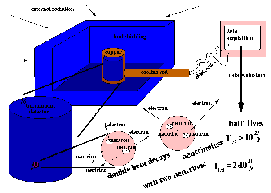The HEIDELBERG-MOSCOW EXPERIMENTwith enriched 76Ge |

The HEIDELBERG-MOSCOW-Experiment is a German-Russian Collaboration of the Max-Planck-Institut für Kernphysik and the Russian Science Center Kurchatov Institute Moscow to search for neutrinoless Double Beta decay of 76Ge.
Double Beta decay corresponds to two simultaneous beta transitions in one nucleus. Double Beta decay with emission of two antineutrinos (2vBB) with half lives in the region of 1021 years, one of the rarest processes in nature, has been already observed for 9 isotopes in different experiments. More exciting is the search for neutrinoless Double Beta decay (0vBB), which is possible in models with neutrino Majorana masses. The observation of 0vBB would imply new physics beyond the Standard Model of particle physics. The present limit gives the sharpest constraint limits on the neutrino mass and on the parameter space of some theories beyond the Standard Model (SUSY, Left-Right Symmetric Models, Leptoquarks, Compositeness...) which is potentially important for future colliders.
The HEIDELBERG-MOSCOW-Experiment is operated with five Detectors [1,2] of overall 10.9 kg enriched to 86% in the BB-emitter 76Ge in the Gran Sasso Underground Laboratory in Italy. The sensitivity of this setup corresponds to an experiment of more than 1.2 t of natural Ge. In the Underground Lab the external muon flux is reduced by 6 orders of magnitude and further shielding is provided by the lead box and nitrogen flushing of the detectors. Another reduction by a factor of five has been obtained due to the installation of a new developed method of Digital Pulse Shape Analysis to discriminate background gamma events from beta counts. .
Our final result for the half life of neutrinoless double beta decay is:
T = (2.23 +0.44
-0.31) x 1025 years
|
Two-neutrino
accompanied half-life:
|
Under the assumption,
that only one of the
terms contributes to the dacey process,
and ignoring potential other processes connected with SUSY theories,
leptoquarks, compositeness, etc.
we find:a neutrino Majorana mass
m v= (0.32
+0.03 -0.03) eV
|
< eta > == (3.05 +0.26
-0.25) 10-9
|
< lambda > == (6.92 +0.58
-0.56) 10-7
|
This range includes already an assumed 50% uncertainty in the nuclear matrix element.
The status of the HEIDELBERG-MOSCOW-EXPERIMENT
and status and future potential of other experiments are shown in these
pictures:


Sketch of our Double Beta Decay Experiment (click for large picture).

To get an impression of the experimental setup click our
picture gallery.
Recent Publications (till 2001)
,H.V. Klapdor-Kleingrothaus, A. Dietz, H.V. Harney and I.V. Krivosheina,
Modern Physics Letters A, Vol. 16, No. 37 (2001) 2409-2420
World Scientific Publishing Company
H.V. Klapdor-Kleingrothaus and U. Sarkar,
Modern Physics Letters A, Vol. 16, No. 38 (2001) 2469-2482
World Scientific Publishing Company
Latest results from the HEIDELBERG-MOSCOW double beta decay experiment,
H.V. Klapdor-Kleingrothaus, A. Dietz, L. Baudis, G. Heusser, I.V.
Krivosheina, B. Majorovits, H. Paes, H. Strecker, V.Alexeev, A. Balysh,
A. Bakalyarov, S.T. Belyaev, V.I. Lebedev and S. Zhukov, Nuclear Physics
A, Volume 694, Issue 1-2, (2001) pp. 269-294.
Critical view on double-beta decay matrix elements within Quasi Random Phase Approximation-based methods, S. Stoica and H.V. Klapdor-Kleingrothaus, Nuclear Physics A, Volume 694, Issue 1-2, 2001, pp. 269-294
Neutrinoless double--decay matrix elements within the second quasirandom phase approximation method, S. Stoica and H.V. Klapdor-Kleingrothaus, Phys. Rev. C 63 (2001) 064304
Double-Beta Decay Matrix Elements for 76Ge, S. Stoica and H.V. Klapdor-Kleingrothaus, to be publ. (2000)
Ten Years of HEIDELBERG-MOSCOW Experiment - a Fresh Look, H.V. Klapdor-Kleingrothaus, in Proc. of the International Symposium on Advances in Nuclear Physics, eds.: D. Poenaru and S. Stoica, World Scientific, Singapore (2000) 123 - 129 pp
Digital pulse shape analysis by neural networks for the HEIDELBERG-MOSCOW double beta-decay experiment, B. Majorovits and H.V. Klapdor-Kleingrothaus, Eur. Phys. J. A6: 463 - 469 (1999) and hep-ex/9911001
Identification of single site events in germanium detectors by digital pulse shape analysis, J. Hellmig and H.V. Klapdor-Kleingrothaus, Nucl. Instrum. Meth. A (2000)
Limits on the
Majorana neutrino mass in the 0.1 eV range
HEIDELBERG-MOSCOW-COLLABORATION, Phys. Rev. Lett. 83 (1999) 41-44
High purity Germanium Detector ionization pulse shapes of nuclear recoils, gamma interactions and microphonism,L. Baudis, J. Hellmig, H.V. Klapdor-Kleingrothaus, Y. Ramachers, J.W. Hammer, A. Mayer Nucl. Instrum. Meth. A 418 (1998) 348 - 354 or hep-ex/9901028
The HEIDELBERG-MOSCOW experiment: improved sensitivity for 76Ge neutrinoless double beta decay, HEIDELBERG-MOSCOW-COLLABORATION, Physical Letters B 407 (1997) 219-224 [73kb]
The HEIDELBERG-MOSCOW BB Experiment with 76Ge: Full Setup with Five Detectors, HEIDELBERG-MOSCOW-COLLABORATION, Phys. Rev. D55 (1997) 54
For a current collection of new papers from our group look at this URL.
Last modification: I.Krivosheina 25/08/2009
 Gran-Sasso
Gran-Sasso